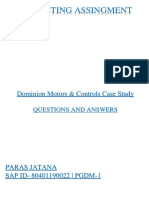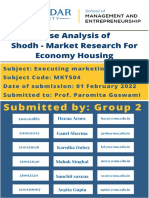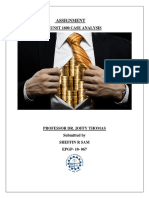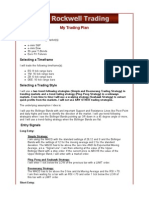Dominion Motors Case
Dominion Motors Case
Uploaded by
ankitkalra1986Copyright:
Available Formats
Dominion Motors Case
Dominion Motors Case
Uploaded by
ankitkalra1986Copyright
Available Formats
Share this document
Did you find this document useful?
Is this content inappropriate?
Copyright:
Available Formats
Dominion Motors Case
Dominion Motors Case
Uploaded by
ankitkalra1986Copyright:
Available Formats
CHANDANA L. GARIMA TAMUDIA KRITI SINGHAL POOJA BERIA S.
MADHULA RAJASURYA
The leading manufacturer Dominion motors in Canada having aquired 50% of the available market for oil pumping motors is threatened by a loss of market share in oilfield pumping motors because the Hamilton Oil Company, having tested several competing motor brands, finds the competitor Spartan Motors motor to be superior.
1Reduce the price of DMCs 10hp motor to that of the 7 -hp motor, 2 Reengineer DMCs present 71/2 hp motor to make its starting torque atleast equal to that of spartans 7 hp unit, 3 Undertake design offer definite purpose motor for the oil well pumping market. 4Attempt to persuade Bridges and Hamilton executives that another set of conclusions could be drawn from the test results.
Hamilton is the largest producer with 30% share on oil producing wells. 80% of the Dominion market is large business users. Estimation that 1000 new wells per year would come up in the next 5 years. The season of highest sales is between April and September. Many small oil operators follow large companies for purchasing policy and equipment choice.
Reduce the price of DMCs 10 hp motor to that of 71/2 motor. Actual Price of 10-hp motor= $1580 New Reduced price = $ 1200 Suppose considering per unit sales:
Scenario Cost incurred
Sales + Transport Cost
Total Cost
Selling Price
Profit
current Future
907.80 907.80
158 120
1065.8 1027.80
1580 1200
514.20 172.20
Profits get reduced by $342 / unit. PROS: This is a quick initial way to meet the problem requirements. The company sales would not be affected for the current season. They get more time to analyze Bridges test and derive their own conclusions
Cons: Reduced profits. Extra expense for user. For 71/2 hp motor, the electrical consumption = $21.5 *7 =$161.5 For 10 hp motor, the electrical consumption = $20 * 10=$200 Therefore extra expense of $38.5 for the user. This is not a long run solution. If the power companies start penalizing for overmotoring, the customers would be at risk.
Two ways of Reengineering 71/2 hp motor. 1. Increasing torque with increase in temperature. 2. Increasing torque with increase in frame size.
Manufactur ing cost Fixed cost Sales commissio n(8%) + transport cost(2%) Total cost
options
Selling Price
Profit
1.
2.
current
790
867 663.51
50.49
50.40 50.49
120
120 120
960.49
1037.49 834
1200
1200 1200
239.51
162.51 366
Going by this alternative would violate NEMA standards and would lead to unbalanced motor design. Even the cost analysis shows a reduced profit, hence this alternative is not feasible.
PROS: No additional investment in plant and equipment is required. Required Torque capacity is achieved. CONS: Reduced profits. Equipment set up time is 3 months. Will start torque war which would be detrimental to the motor industry. Customer reaction to the new product is uncertain. The companys policy of maintaining NEMA standards is being violated.
Considering the definite purpose motor specification 5 hp unit having torque of a 10 hp motor.
Monthly power charge paid acc. To horse power.
Horse power(hp) Base rate/horse power($) 5 7 1/2 10 25 21.50 20.00 Monthly power base rate($) 125 161.25 200
By using 5 hp motor instead of 10 hp motor the user can save 75$ /month and 75*12=900$ / year. This 5 hp can be sold for a minimum price of $1045 and maximum price of $1200. Referring to exhibit 2:
hp
5
Manufacturing cost
$511.53
Total cost
571.20
Fixed cost here is 571.20 511.53=$59.67 But the manufacturing cost of Definite purpose motor comes around $665. Including the sales commission and transportation cost(10%) . i.e $104.5 for ($1045 S.P ) and $120 for (S.P $1200)
Selling Price($)
1045 1200
*Total cost ($)
829.17 844.67
Profit($)
215.83 355.33
* Total Cost includes manufacturing cost, fixed cost and sales commission and transportation cost.
Therefore, % hp motor can be sold for $1200 with a profit of $355.33 According to industry estimates, an average of 1000 new wells would be added every year. But this alternative requires an investment of $75000 for the required engineering and testing. Therefore, Total sales from profit would be 1000 * 355.33= $355,330 Hence, the pay back time for the initial setup cost would be 75000/355330=0.21 years Hence , this alternative can be adopted as the profit is considerable with less pay back time and DMC Ltd. Can catch up with its competitors. CONS: The new wells coming up may require different motors. Small companies may not want the same motor that Hamilton wants. Also it would take 4 or 5 months for the production to begin.
Pros: Not necessary to change the product and market strategy Cons: Bridges is more convinced of his interpretations and its difficult to meet him directly Presentation of different arguments is not known Even if we try to alternate Bridges recommendations it would only generate ill will. Additional alternative: Some executives believed that DMC should begin testing and defining the motor needs of the companies various market segments as it would be a long term investment in maintaining DMCs future market position. But it requires additional hiring.
As soon as the Bridges results gets published DMC can take up Alternative 1 to retain the market share in the current selling season. To make this alternative more attractive the minimum marginal profit can be retained and additional discount can be provided over and above 45%.
And parallely DMC must work on Alternative 3 and launch a customized product for the Canadian market (which is strongly influenced by BRIDGES result)
You might also like
- Morningstar Report-636d1777e26a17cb5799129dDocument22 pagesMorningstar Report-636d1777e26a17cb5799129ddantulo1234No ratings yet
- Group 2 LTCLDocument6 pagesGroup 2 LTCLShubham Srivastava0% (3)
- Haas School of Business BA 160 Marketing Prof. A. BauerDocument11 pagesHaas School of Business BA 160 Marketing Prof. A. BauerKartik LadNo ratings yet
- Dominion Motors & Controls, LTDDocument7 pagesDominion Motors & Controls, LTDMahnoor MaalikNo ratings yet
- Brighter Smile For The MassesDocument1 pageBrighter Smile For The MassesRohanNo ratings yet
- Precise Software Solutions Case StudyDocument3 pagesPrecise Software Solutions Case StudyKrishnaprasad ChenniyangirinathanNo ratings yet
- GE and The Industrial InternetDocument1 pageGE and The Industrial InternetMaha KhanNo ratings yet
- Case 5 - Honda TodayDocument3 pagesCase 5 - Honda TodayArpit KumarNo ratings yet
- Kriyanshi Aggarwal - 2015PGP178 - Hybrid Agile Approach CaseDocument3 pagesKriyanshi Aggarwal - 2015PGP178 - Hybrid Agile Approach CaseKriyanshi AggarwalNo ratings yet
- Northern Chemical Company: Business MarketingDocument9 pagesNorthern Chemical Company: Business MarketingEshan GuptaNo ratings yet
- Meagal StelplastDocument7 pagesMeagal StelplastShaunJaiprakash100% (3)
- Discussion Questions - D.light CaseDocument2 pagesDiscussion Questions - D.light CaseAhmad DaasNo ratings yet
- PV Technologies - Mayank DubeyDocument2 pagesPV Technologies - Mayank DubeyMayankDubeyNo ratings yet
- Dominion Motor CaseDocument3 pagesDominion Motor Caseabhijeet pandeNo ratings yet
- Dominion Motors and Controls: Althaf, Abhay, Harsh, Gayatri, Kanika, LakshyaDocument10 pagesDominion Motors and Controls: Althaf, Abhay, Harsh, Gayatri, Kanika, LakshyaSakura2709No ratings yet
- Dominion Motors Controls Ltd.Document4 pagesDominion Motors Controls Ltd.Naveen Chander DharNo ratings yet
- Dominion Motors and Controls LTDDocument7 pagesDominion Motors and Controls LTDRavinder Kumar100% (1)
- Dominion Motors & Controls, LTDDocument6 pagesDominion Motors & Controls, LTDdileepNo ratings yet
- Marketing Assingment: Dominion Motors & Controls Case StudyDocument4 pagesMarketing Assingment: Dominion Motors & Controls Case StudyParas JatanaNo ratings yet
- Dominion Motors and Controls Ltd. - Case AnalysisDocument7 pagesDominion Motors and Controls Ltd. - Case Analysisdhiraj agarwalNo ratings yet
- Dominion Motors LTDDocument5 pagesDominion Motors LTDutkarshdave100% (1)
- Case Analysis - Dominion MotorsDocument2 pagesCase Analysis - Dominion MotorsNEHA JENA IPM 2018 BatchNo ratings yet
- Case Study Analysis - ScorpioDocument8 pagesCase Study Analysis - Scorpiosubhadip100% (1)
- Case Colgate Vs P&GDocument1 pageCase Colgate Vs P&GHarshal Gadge0% (1)
- Jackson Case Group5Document5 pagesJackson Case Group5SIDDHANT MOHAPATRANo ratings yet
- Computron Inc NotesDocument4 pagesComputron Inc Notesfrenchy15100% (1)
- Group 2 - Shodh Case Analysis - MKT504Document6 pagesGroup 2 - Shodh Case Analysis - MKT504Arpita GuptaNo ratings yet
- MBM Case 2 - Kunst 1600Document4 pagesMBM Case 2 - Kunst 1600Ujjwal BhardwajNo ratings yet
- B2B Brand Pipe-2Document10 pagesB2B Brand Pipe-2IIMB SumitNo ratings yet
- B2B - Group 3 - Jackson Case StudyDocument5 pagesB2B - Group 3 - Jackson Case Studyriya agrawallaNo ratings yet
- EkohealthDocument3 pagesEkohealthSARATH RAM P PGP 2019-21 BatchNo ratings yet
- Strategic Management: Case Analysis: Brighter Smiles For The Masses - Colgate vs. P&GDocument14 pagesStrategic Management: Case Analysis: Brighter Smiles For The Masses - Colgate vs. P&GHimanshu VermaNo ratings yet
- Case AnalysisDocument3 pagesCase AnalysisVIPUL TUTEJANo ratings yet
- Mekanism Case StudyDocument8 pagesMekanism Case StudyIshanNo ratings yet
- Computron CaseDocument4 pagesComputron CaseZafar Ibrahim (M20MS074)No ratings yet
- Group 7 - Asclepius ConsultingDocument22 pagesGroup 7 - Asclepius ConsultingShailanchal Uniyal100% (1)
- Barco Projection SystemsDocument17 pagesBarco Projection SystemsJaideep ChauhanNo ratings yet
- Salesand Distribution Management: Eco7: Launching A New Motor OilDocument16 pagesSalesand Distribution Management: Eco7: Launching A New Motor OilAbhishek GautamNo ratings yet
- Abb CatDocument9 pagesAbb CatMukesh Kumar MeenaNo ratings yet
- Industrial Chemical Inc - Pigment DivisionDocument8 pagesIndustrial Chemical Inc - Pigment DivisionRahul NiranwalNo ratings yet
- MBM-Precise Case SolutionDocument7 pagesMBM-Precise Case SolutionUjjwal BhardwajNo ratings yet
- Computron Inc - Wac ReportDocument10 pagesComputron Inc - Wac ReportnilayjNo ratings yet
- Gillette'S Energy Drain (A) : The Acquisition of DuracellDocument3 pagesGillette'S Energy Drain (A) : The Acquisition of DuracellNANo ratings yet
- Case Analysis Aniket Bothare MBM PVTDocument4 pagesCase Analysis Aniket Bothare MBM PVTAniket BothareNo ratings yet
- Toyota Motor Manufacturing USA., inDocument5 pagesToyota Motor Manufacturing USA., inmudasserNo ratings yet
- Clean Edge Razor Case AnalysisDocument12 pagesClean Edge Razor Case AnalysisAbirNo ratings yet
- Assignment: Kunst 1600 Case AnalysisDocument5 pagesAssignment: Kunst 1600 Case AnalysisSheffin SamNo ratings yet
- PCCBS PepsiCo CaseDocument8 pagesPCCBS PepsiCo CaseVaibhav Singh100% (1)
- Brighter Smiles For The Masses - PPTDocument6 pagesBrighter Smiles For The Masses - PPTANANTHA BHAIRAVI M100% (1)
- PV-Technologies-Group 2Document28 pagesPV-Technologies-Group 2VershaNo ratings yet
- Answering Questions For GiveIndia Case StudyDocument2 pagesAnswering Questions For GiveIndia Case StudyAryanshi Dubey0% (2)
- ABB and Caterpillar (A) : Key Account Management: Case ReportDocument2 pagesABB and Caterpillar (A) : Key Account Management: Case ReportSonaliCaffreyNo ratings yet
- Infosys: Growing Share of Customer Business: Group 1Document8 pagesInfosys: Growing Share of Customer Business: Group 1Suryansh SinghNo ratings yet
- Pepsico CaseDocument8 pagesPepsico CaseAkshay tyagiNo ratings yet
- Commercializing The Kunst 1600 Dry Piston Vacuum Pump: B2B MarketingDocument14 pagesCommercializing The Kunst 1600 Dry Piston Vacuum Pump: B2B MarketingAshish GondaneNo ratings yet
- OTISLINE PresentationDocument5 pagesOTISLINE PresentationAseem SharmaNo ratings yet
- Barco Case AnalysisDocument2 pagesBarco Case Analysisaparna jethaniNo ratings yet
- Managing Business Markets (MBM) : Case Analysis Note - Kunst1600 - Understanding Customer ValueDocument6 pagesManaging Business Markets (MBM) : Case Analysis Note - Kunst1600 - Understanding Customer ValueRohit SharmaNo ratings yet
- Shodh Marketresearchforeconomyhousing 171207061406Document8 pagesShodh Marketresearchforeconomyhousing 171207061406Ritika SharmaNo ratings yet
- Dominion Motors & Controls LTDDocument15 pagesDominion Motors & Controls LTDAmil BansalNo ratings yet
- Sai Charan Perugu Dominion Case AnalysisDocument5 pagesSai Charan Perugu Dominion Case AnalysismmsrajuNo ratings yet
- Benefeciality Speech - Rice Tarrification Law Should Not Be RepealedDocument2 pagesBenefeciality Speech - Rice Tarrification Law Should Not Be RepealedPJ JavierNo ratings yet
- 336 CH 9 Optimal Capital Structure (M&M)Document9 pages336 CH 9 Optimal Capital Structure (M&M)amitNo ratings yet
- ABM - AE12 - 006 - The Philippine Peso and The Foreign CurrencyDocument36 pagesABM - AE12 - 006 - The Philippine Peso and The Foreign CurrencyAries Gonzales Caragan71% (38)
- 04 Candlestick PatternsDocument11 pages04 Candlestick PatternsTreasure FoundNo ratings yet
- Hra Valuation Methods PDFDocument35 pagesHra Valuation Methods PDFJayashree UNo ratings yet
- Energy: The Transition From Depletable To Renewable ResourcesDocument35 pagesEnergy: The Transition From Depletable To Renewable ResourcesMuhammad Jahanzeb AamirNo ratings yet
- Performance AppraisalDocument54 pagesPerformance AppraisalbasheerNo ratings yet
- Q. List The Four Components of GDP. Give An Example of EachDocument2 pagesQ. List The Four Components of GDP. Give An Example of EachZahra زاهراNo ratings yet
- Chap 6-Supply, Demand & Government PoliciesDocument30 pagesChap 6-Supply, Demand & Government PoliciesKhánh AnNo ratings yet
- CH 10 FMDocument30 pagesCH 10 FMshubakarNo ratings yet
- Financial Statements, Cash Flows, and Taxes: Learning ObjectivesDocument54 pagesFinancial Statements, Cash Flows, and Taxes: Learning ObjectivesShoniqua Johnson100% (1)
- Equity and Efficiency ProblemsDocument1 pageEquity and Efficiency ProblemsAna HernNo ratings yet
- ECS2602Document53 pagesECS2602wycliff brancNo ratings yet
- Amusements in MathematicsDocument353 pagesAmusements in Mathematicshjalvino9446No ratings yet
- Sanitary Napkin Growth StrategyDocument7 pagesSanitary Napkin Growth StrategySmokeySr LnuNo ratings yet
- Contrarian Investment ExtrapolationDocument11 pagesContrarian Investment ExtrapolationB.C. MoonNo ratings yet
- Nishat TextileDocument18 pagesNishat TextileHoor PariNo ratings yet
- IBM 1003 Case 4 Haniff MachiningDocument6 pagesIBM 1003 Case 4 Haniff Machininggawde99saketNo ratings yet
- Questionnaire For WalletDocument4 pagesQuestionnaire For WalletShubhendu Tiwari0% (1)
- Basic Microeconomics 05 Notes 2ndsem2021 22Document2 pagesBasic Microeconomics 05 Notes 2ndsem2021 22Hannah Gwen LimosNo ratings yet
- 5Document2 pages5Katie NguyenNo ratings yet
- Faculty of Liberal Studies BBA (Hons.) Semester - I Division - CDocument13 pagesFaculty of Liberal Studies BBA (Hons.) Semester - I Division - CPrince BharvadNo ratings yet
- DCF Model TemplateDocument6 pagesDCF Model TemplateHamda AkbarNo ratings yet
- Short Selling Strategies and MarginDocument6 pagesShort Selling Strategies and Marginsawilson1No ratings yet
- Mumbai DabbawalaDocument31 pagesMumbai DabbawalaKunal RaghuwanshiNo ratings yet
- Trizia Mari OliverJanuary 27Document2 pagesTrizia Mari OliverJanuary 27Z VerNo ratings yet
- Accounting FirstDocument24 pagesAccounting Firstmagdy kamelNo ratings yet
- India Pre Owned Car Market Report 2nd Edition 2017 PDFDocument52 pagesIndia Pre Owned Car Market Report 2nd Edition 2017 PDFJinalS0% (1)
- Markus Trading PlanDocument3 pagesMarkus Trading PlanAmarrdiip KumaarrNo ratings yet

























































































